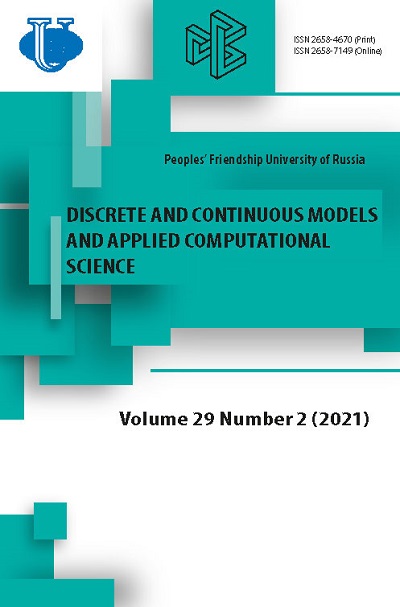Calculation of special functions arising in the problem of diffraction by a dielectric ball
- Authors: Malyshev K.Y.1
-
Affiliations:
- Skobeltsyn Institute of Nuclear Physics Lomonosov Moscow State University
- Issue: Vol 29, No 2 (2021)
- Pages: 146-157
- Section: Articles
- URL: https://journals.rudn.ru/miph/article/view/26869
- DOI: https://doi.org/10.22363/2658-4670-2021-29-2-146-157
Cite item
Full Text
Abstract
To apply the incomplete Galerkin method to the problem of the scattering of electromagnetic waves by lenses, it is necessary to study the differential equations for the field amplitudes. These equations belong to the class of linear ordinary differential equations with Fuchsian singularities and, in the case of the Lüneburg lens, are integrated in special functions of mathematical physics, namely, the Whittaker and Heun functions. The Maple computer algebra system has tools for working with Whittaker and Heun functions, but in some cases this system gives very large values for these functions, and their plots contain various kinds of artifacts. Therefore, the results of calculations in the Maple’11 and Maple’2019 systems of special functions related to the problem of scattering by a Lüneburg lens need additional verification. For this purpose, an algorithm for finding solutions to linear ordinary differential equations with Fuchsian singular points by the method of Frobenius series was implemented, designed as a software package Fucsh for Sage. The problem of scattering by a Lüneburg lens is used as a test case. The calculation results are compared with similar results obtained in different versions of CAS Maple. Fuchs for Sage allows computing solutions to other linear differential equations that cannot be expressed in terms of known special functions.
Full Text
1. Introduction The problem of diffraction of a plane electromagnetic wave by a ball with an arbitrary radially symmetric filling allows the construction of an analytical solution by the incomplete Galerkin method [1]. Let us make use of a spherical coordinate system and assume that the dielectric constant of the ball
About the authors
Ksaverii Yu. Malyshev
Skobeltsyn Institute of Nuclear Physics Lomonosov Moscow State University
Author for correspondence.
Email: kmalyshev08102@mail.ru
ORCID iD: 0000-0001-8823-9136
engineer, Skobeltsyn Institute of Nuclear Physics
GSP-1, Leninskie Gory, Moscow, 119991, Russian FederationReferences
- A. G. Sveshnikov and I. E. Mogilevsky, Matematicheskiye zadachi teorii difraktsii [Mathematical problems of the theory of diffraction]. Moscow: MSU, 2010, In Russian.
- G. Mie, “Beiträge zur Optik trüber Medien, speziell kolloidaler Metallösungen,” Annalen der Physik, vol. 25, no. 3, pp. 377-445, 1908. doi: 10.1002/andp.19083300302.
- C. F. Bohren and D. R. Huffman, Absorption and scattering of light by small particles. New York: John Wiley & Sons, 1983.
- C. Mätzler, MATLAB Functions for Mie Scattering and Absorption, Institute of Applied Physics, University of Bern, June 2002. Research Report No. 2002-08 http ://arrc.ou.edu/~rockee/NRA_2007_ website/Mie-scattering-Matlab.pdf, 2002.
- J. Lock, “Scattering of an electromagnetic plane wave by a Luneburg lens. II. Wave theory,” Journal of the Optical Society of America A: Optics Image Science and Vision, vol. 25, pp. 2980-2990, 2008. doi: 10.1364/JOSAA.25.002980.
- Waterloo Maple (Maplesoft), Symbolic and numeric computing environment Maple, https://www.maplesoft.com/, 2019.
- F. G. Tricomi, Differential equations. London: Blackie & Sons ltd., 1961.
- The Sage Developers, SageMath, the Sage Mathematics Software System (Version 7.4), https://www.sagemath.org, 2016.
- National Institute of Standards and Technology (NIST), United States, Digital Library of Mathematical Functions. Version 1.1.1, https://dlmf. nist.gov, 2021.
- A. F. Nikiforov and V. B. Uvarov, Special Functions of Mathematical Physics. A Unified Introduction with Applications. Springer Basel AG, 1988.
- S. Y. Slavyanov and W. Lay, Special functions: unified theory based on singularities. Oxford: OUP, 2000.
















